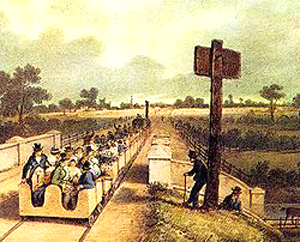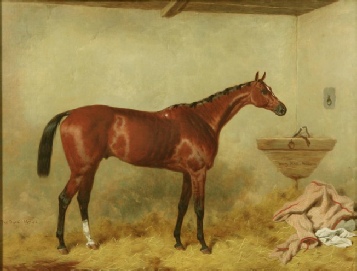


|
The Griffins of Stockton Fields (later Hill Farm) 1817- 3< Page 4 Steeplechasing at Stockton Fields |

|
Mr. Ind had two “somersets”, and pulled up, an example soon followed by his companions in the rear. On proceeding to the last hedge, a fearful leap of ten or eleven feet, on rising ground, his Grace and Single Peeper were evidently waiting for each other to make a gap, but neither seemed inclined to lead. At length "Gomm's old- Single Peeper, who had long been peeping for so desirable an opportunity, availed himself of it instantly, and sprang by The Duke. His grace, by no means wishing to retire from a contest in which he had hitherto taken the lead, sprang forward, and was again soon by the side of the old horse. Both had now arrived in the field where the flag, as the goal of success, had been placed, when it was found that the party having charge of it had removed it from its original position in the hedge, to the middle of the field. The struggle was a severe one, the Duke, passing his old antagonist by half- A dispute here arose, which, had an umpire been appointed prior to the race, could have been instantly decided. The friends of Mr. Gomm contended that inasmuch as he entered the field and arrived first at the nearest point to the spot where the flag originally stood, he was entitled to the stakes. Mr. Sirdefield, on the other hand, contended that as he was nearest to the flag- Upon the whole the race was a good one: the riding of Mr. Sirdefield was much admired; and Single Peeper was ridden by Denwick, a groom in the employ of Sir Edward Mostyn, in a very creditable manner. Mr. Sirdefield offered to turn his horse's head and run the same ground, for 100 sovereigns. The parties left the ground mutually dissatisfied; but on Thursday evening last a meeting was held at Leamington, when it was agreed to refer the matter to two sporting men, a third party to be named if necessary, and his decision to be final. The cup is of beautiful chased silver, and holds three bottles. In The Duke, the Stockton race has a surprising connection with a rather more famous one. Around 15 months later, on March 5 1836, the Bolton Chronicle published an item headed LIVERPOOL GRAND STEEPLE CHASE, describing it as “the first steeple chase ever run in the neighbourhood of Liverpool [and which] came off in the enclosed grounds near the Aintree racecourse”. It was in fact only in 1810 that the first steeplechase with a prepared course had been run, at Bedford. For the last part of the 1836 race the runners entered the racecourse and finished by the grandstand. This was the precursor of the first “official” Grand National in 1839, but is today held to be th Another novelty was that “the Aintree police were on the ground, and preserved excellent order”. In the early 1800s, although Liverpool’s population was around 250,000, it only had parish constables and watchmen to keep order. The first uniformed, fully professional police force in the country had only been constituted in 1829, when Sir Robert Peel’s Peelers (later Bobbies) appeared on the streets of London. Marked by flags, “the line of road was excellently adapted for the display of the activity of the horses, and the ingenuity and intrepidity of the riders, being intersected with ditches, dangerous fences, and ploughed fields”. The Liverpool- It seems hardly surprising that the winner of the Stockton steeple chase had been The Duke, since not only was he one of the ten runners here, but he again came home first. The prize was 180 sovereigns, nearly £20,000 today; this time, owner Mr Sirdefield was a spectator. The rider in Mr Sirdefield’s lilac and white colours was none other than Captain Becher, who during that first 1839 Grand National fell in the brook that as a result was named after him. In fact he remounted, but fell again into a second brook! In a repeat “Grand Liverpool Steeplechase” in 1837, The Duke won again, with a different rider. He was third in 1838, but did not run in the first official Grand National in 1839. The 1837 and 1838 races were in fact not too grand, as they only attracted four and three runners respectively, whereas by 1839 the steeplechase was under new management and had seventeen.
In May 1836, Sirdefield was back at Aintree and this time rode The Duke, in a field including Becher, who beat him. However, the reporter notes, “two other races took place between some ‘cock- It has not been possible to establish Mr Sirdefield’s identity in detail but in 1836 he was landlord of the George Inn, Great Crosby, Liverpool. How he got to race at Stockton is rather a mystery, but he regularly competed at other race meetings than Aintree, as rider, owner- “The Duke in a stall at Newmarket”, by Harry Hall The races referred to above were for “gentlemen”, i.e. amateurs, in an era when professional sport was developing. Until not long before the first National, it was a rule that to be eligible, steeplechasers had to have hunted for a minimum number of days in the year, and the Duke was second favourite in 1836 based on his reputation in the hunting field. We do not know if William Griffin rode to hounds, but the family apparently liked the races – the illustration at the beginning of this piece is taken from an 1855 race card for “Coventry Races and Steeple Chases” which has survived among Griffin family papers. THE STORY OF THE GRIFFINS OF STOCKTON FIELDS - |
| 2 Sitemap |
| 3 Maps |
| Late Victorian map of Stockton |
| Pre 1844 O.S. map Stockton-Long Itchington |
| Stockton Fields - 2 |
| Stockton Fields - 3 |
| Stockton Fields - 4 |
 e actual first in all but name. It drew immense crowds, “many with their own telescopes”. Some punters might even have come by train.
e actual first in all but name. It drew immense crowds, “many with their own telescopes”. Some punters might even have come by train.